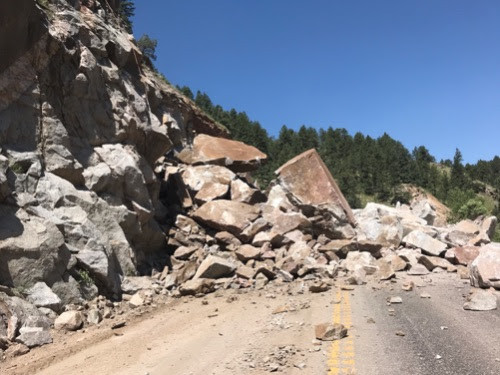
“Ding, Ding”
Fast asleep under the down comforter, I thought I dreamed it. A doorbell, maybe?
Nope, it was my cell phone. Picking it up, I glanced at the time — 5:08 a.m. Who could be messaging me at this hour? Maybe an east coast friend…
“Boulder Canyon closed at MM 39-40 due to a natural rock slide.”
Thank God I have a telecommute day.
Where there is a canyon, you will have rock slides. It’s inevitable.
But rock slides are much more frequent during colder times of the year. Why?
It’s all about the power of water, especially in a frozen form and the geology of the Rocky Mountains.
Along the Front Range, the mountains are mostly made of granite. The granite is being forced up ever higher as tectonic plates collide. Something has to give. And that something is the rock being forced every higher above the earth’s surface.
Geology has never been easy for me to understand or explain. Fortunately, during my career in the Park Service, I worked at many parks where the geology was a central theme. My favorite way to explain the plates on the earth was to think of a soccer ball. Think of the black and white sections as plates floating on the earth’s surface. Sometimes like a ship hitting an iceberg, they collide.
And like the Titanic, that collision forces something up — mountains. As the mountains continue to lift up, the rocks get fissures or cracks in them. Which is very good for rock climbers or they might have a much harder time climbing in Boulder Canyon.
But those same cracks allow water to seep down in them. This is especially true in winter and spring where snow accumulates, then melts during the day, seeping into the cracks. Then overnight, the water freezes and starts to expand, which is called ice wedging.
The ice exerts pressure on the rock and eventually the rock gives way, tumbling to the ground. Given that we had lots of snow falling and cold temperatures, it’s no surprise the rock slide occurred in the wee hours of the morning. And it wasn’t the only one — Clear Creek Canyon also had a rock slide today blocking part of the roadway.
I experienced the power of a rock slide first hand in one of the most famous national parks, Yosemite. Strangely, this occurred in the middle of summer in July, 1996. While visiting a ranger friend at Glacier Point, the ground started to rumble.
“Earthquake!” I yelled.
It only lasted a few seconds, but my heart pounded as I stood underneath a pine tree. Finally, the shaking subsided. A huge cloud of dust rose up from the valley below, causing me to cough and wipe my eyes.
“What happened?” I asked my friend.
“I don’t know, let me get my radio.”
As it turned out, an enormous section of the rock face had collapsed spilling over 90,000 cubic feet of rock down to the valley floor 2,200 feet below. One person was killed and several injured with the dust coating people, picnic tables and everything else around it like a volcanic blast.
Respect the power of geology and water — together they can produce powerful movement of the earth.

